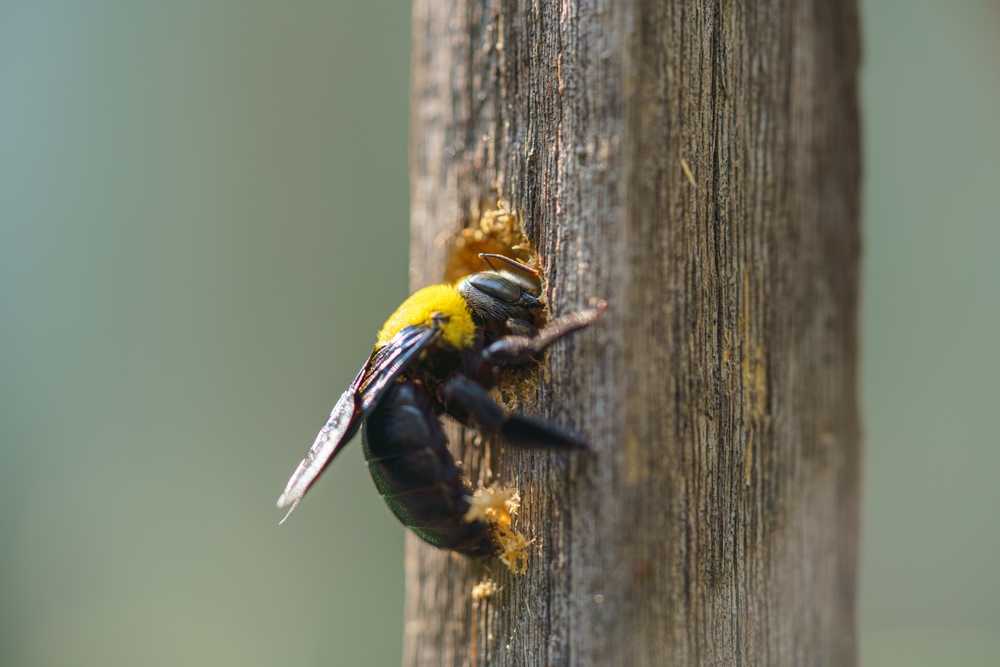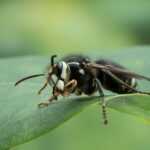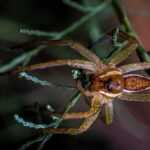Identifying Carpenter Bees: What Does a Carpenter Bee Look Like?
Curious about what a carpenter bee looks like? These wood bees are easily identified by their smooth, shiny black abdomens and lack of yellow markings, unlike the fuzzy bumble bees. In this article, you’ll learn how to recognize carpenter bees, understand the differences from bumble bees, and identify signs of their carpenter bee activity and carpenter bee infestation.
- Carpenter bees have smooth, shiny black bodies and drill perfectly round holes in untreated wood, distinguishing them from bumblebees.
- Male carpenter bees have white markings on their heads and cannot sting, while female bees are pure black and can sting, albeit rarely and only when provoked.
- Carpenter bees are most active from early spring through early summer into fall, with specific activity periods depending on regional temperatures and conditions.
Recognizing Carpenter Bees
Carpenter bees are characterized by their smooth, shiny abdomens, which lack the yellow markings found on other bees. Their sleek, black bodies set them apart from the fuzzy appearance of bumblebees. Typically, carpenter bees range in size from 0.34 to 1 inch in length, making them quite noticeable when they are around.
One of the most distinctive features of carpenter bees is their ability to drill perfectly round carpenter bee holes into exposed, unfinished wood, about half an inch in diameter. These eastern carpenter bees are solitary insects, meaning they do not live in colonies like honey bees or bumblebees. Instead, each female carpenter bee creates her own gallery by boring into untreated, soft wood such as pine or cedar to lay a single egg. The nests can extend up to two feet or more, providing ample space for their brood cells.
Recognizing these shiny black bees and their characteristic holes in wooden structures helps identify a carpenter bee infestation. Trails of wood shavings and sawdust, along with the sound of drilling, often indicate their presence. Early detection can prevent significant structural damage.
Carpenter Bees vs Bumblebees
It is easy to confuse carpenter bees with bumblebees due to their similar size and appearance. However, there are several key differences that can help you tell them apart. Carpenter bees are generally larger, ranging from 0.75 to 1 inch in length, whereas bumblebees are around 0.6 to 1 inch long. The smooth, shiny abdomen of carpenter bees contrasts with the hairy, yellow abdomen of bumblebees.
The heads of carpenter bees are solid black, devoid of any yellow markings. In comparison, bumblebees have black and yellow markings on their heads, making them appear more vibrant. These visual cues are crucial for distinguishing between the two species when you encounter them in your yard or near your house.
Behaviorally, carpenter bees are solitary bees, meaning they do not form colonies like bumblebees. Bumblebees are social insects that live in colonies and are often seen working together to gather nectar and pollen. In contrast, carpenter bees are more likely to be seen alone, either flying to feed or establishing nests in wooden structures.
Understanding these differences aids in properly identifying the bees you encounter and taking appropriate action. The smooth, shiny abdomen of the carpenter bee and the social behavior of the bumblebee are key characteristics for identification.
Male vs. Female Carpenter Bees
Carpenter bees exhibit distinct physical and behavioral differences. Male carpenter bees have white markings on their heads, which are absent in females. In contrast, female bees possess a pure black head, making them easier to identify if you know what to look for.
One of the most significant differences between male and female carpenter bees is their ability to sting. Male carpenter bees cannot sting, relying on their size and territorial behavior to deter threats. Male bees are known to be more aggressive and may exhibit defensive behaviors around their nests. Their lack of a stinger makes them less of a threat to humans, but their protective nature can still be intimidating.
On the other hand, female carpenter bees can sting, but they do so only very rarely and typically only when provoked. Their primary role is to chew into wood and create galleries for their eggs. The nesting process involves drilling into untreated wood to form tunnels where they lay their eggs, providing a safe environment for their larvae to develop.
Recognizing these differences is essential for identifying and managing carpenter bee populations. The distinctive white markings on males and the nesting behavior of females aid in identifying and addressing potential carpenter bee infestations.
Signs of Activity and Infestation
Carpenter bees usually nest in untreated, soft wood such as pine or cedar, making them a common sight around homes with exposed wooden structures. Female carpenter bees are responsible for creating carpenter bee nests by boring into wood to lay their eggs. These nests are often identified by perfectly round holes, about half an inch in diameter.
One of the most visible signs of carpenter bee activity is the presence of wood shavings and sawdust trails left behind as they burrow into wood. Additionally, yellow-brown stains from bee excrement can appear on the wood surface, further indicating their presence. These signs, combined with small piles of sawdust at the base of the holes, are clear indicators of active nests.
Multiple carpenter bees in a small area can signify an infestation, especially if you notice several holes and sawdust trails. The damage caused by carpenter bees can be extensive, leading to structural damage if left untreated. Early detection is key to preventing significant damage and maintaining the integrity of your wooden structures.
Being vigilant and recognizing these signs allows you to address carpenter bee activity before it worsens. Spotting sawdust trails or their characteristic holes aids in managing and preventing infestations, as these pests chew into wood.
Seasonal Activity and Habitats
Carpenter bees are most prevalent in warm climates, with their activity extending from:
- February to October in southern regions
- March to October in the South Central region of the U.S.
- March to October in the North Central zone
- Late March through October in the Northern region
Knowing these seasonal patterns is crucial for effective monitoring and control.
Carpenter bees are most active during early summer and spring, ideal times for inspecting your property for signs of their presence. They prefer nesting in untreated, soft wood, often found in exposed wooden structures like decks, fences, eaves, and siding. Awareness of their preferred environments helps in early nest detection and taking preventive measures to protect your property, especially when considering overwintering bees.
Understanding when and where to find carpenter bees helps you prepare for their activity and reduce infestation risks. Regular inspections during their active periods and addressing potential nesting sites can keep your home safe from damage caused by these wood-boring bees.
Identifying the Carpenter Bee
Carpenter bees, with their distinctive appearance and wood-boring habits, can cause significant structural damage if not identified and managed properly. Recognizing their smooth, shiny abdomens and understanding their nesting behavior are key to early detection. Differentiating them from bumblebees, noting the physical differences between males and females, and identifying signs of their activity can help prevent infestations.
Knowing when and where to find carpenter bees is crucial for effective control. Regular inspections during their active periods and being aware of their preferred nesting sites can help protect your wooden structures. If you suspect a carpenter bee infestation, it’s important to take prompt action to prevent further damage.
Frequently Asked Questions
How can I tell the difference between carpenter bees and bumblebees?
You can differentiate carpenter bees from bumblebees by noting that carpenter bees possess smooth, shiny abdomens and solid black heads, whereas bumblebees have hairy, yellow abdomens with distinct black and yellow markings on their heads.
What are the signs of carpenter bee activity and infestation?
The signs of carpenter bee activity include perfectly round holes in wood, wood shavings and sawdust trails, and yellow-brown stains from their excrement. An increased presence of these bees in a localized area may suggest an infestation.
When are carpenter bees most active during the year?
Carpenter bees are most active from early spring through early summer and into fall, varying by region. Understanding their active months can help you take preventive measures if needed.
Can male carpenter bees sting?
Male carpenter bees cannot sting, as they lack the necessary stinging anatomy. They instead use their size and aggressive behavior to ward off potential threats.
What should I do if I find carpenter bee nests on my property?
If you find carpenter bee nests on your property, it is advisable to contact a professional pest control service to address the infestation and prevent structural damage to your wooden structures. Protecting your property should be your top priority.




